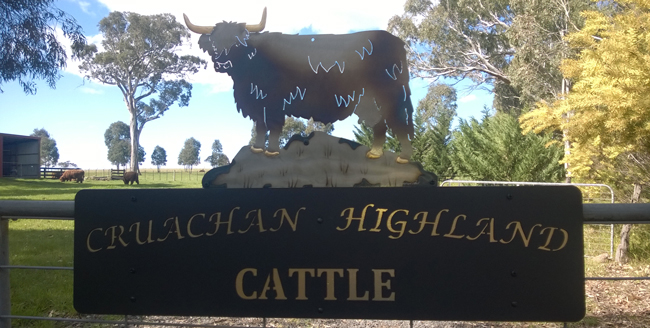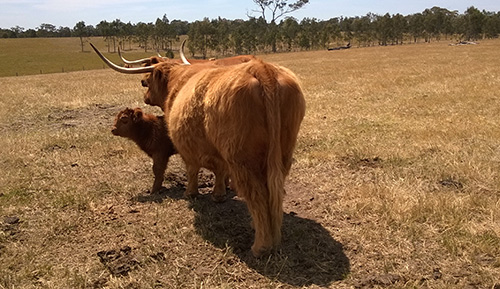


Why breed Highland Cattle, and what are the advantages?
Highland Cattle are an ancient breed, surviving unchanged for centuries in the highlands and islands of Scotland. This says much of their ability to survive in adversity.
Here in Australia they happily exist in poorer conditions than many other types of cattle. The lack of human attempts to "improve" the breed is probably responsible for the true ease of calving exhibited by these animals. That and the fact that they had to be hardy to survive in their native conditions.
We are often asked about shearing them! But this is quite unnecessary. They cleverly grow their winter coats when the temperatures fall and cast them off again in the spring.
This hairy overcoat means the carcass does not lay down the thick layer of surface fat necessary to so many other breeds, so the meat is lean yet full of flavour with just the right amount of marbled fat throughout.
But there's more! Hides from these magnificent animals can be tanned and sold making them more profitable than many other breeds of cattle. They make luxurious rugs with hair about 100-150mm (4"-6") long and can be found in colours from white through yellow to reds and on to black.
Then there are the horns. Polished and mounted they make a magnificent wall hanging.
Animals in Australia, and there are now several thousand registered with the Australian Highland Cattle Society, may be from either graded-up lines or imported lines.
We have been breeding these wonderful, easy care and docile animals since 1987.

Cruachan Fold has selected bloodlines from Scotland, Canada, America and New Zealand, all of whose origins can be traced back to the Highland Cattle Society Herd Book in Scotland.
All our stock are from fully imported bloodlines and are registered with the Australian Highland Cattle Society. Availability of stock for sale can be checked in our Highland Cattle Sales page.
8 great advantages of breeding Highland Cattle.
 1. Genuine ease of calving.
1. Genuine ease of calving.
Other than a few breech births, we have not had to assist at a birth since we started with Highland Cattle in 1987. In years gone by Highland Cattle were mainly left to fend for themselves … they either calved successfully or died in the process. This created a natural culling process which we benefit from today.
 2. High Quality Carcasses.
2. High Quality Carcasses.
Highland Cattle carry very little surface fat but do have a certain amount of fine marbling throughout. Although they are slower to mature than many other breeds, the wait is worth it, with the meat being tender and succulent. (see test results in the article "Pure Highland Beef" listed under Carcass Traits in our Main Menu.) Breeders who develop direct marketing for the meat find it is very much in demand in the home freezer market, and can command top prices per kilogram on "the hook".
 3. Hides.
3. Hides.
The Highland's long coat is made up of two layers — an under-down and longer, coarser outer layer, which protects them from excessive cold and wind. We are often asked about shearing them! But this is quite unnecessary. They cleverly grow their winter coats when the temperatures fall and cast them off again in the spring.
This hairy overcoat means the carcass does not lay down the thick layer of surface fat necessary to so many other breeds, so the meat is lean yet full of flavour with just the right amount of marbled fat throughout.
Hides from these magnificent animals can be sold for almost as much as the meat making them more profitable than your average cattle. They make luxurious rugs with hair about 100-150mm (4"-6") long and can be found in colours from white through yellow to reds and on to black.
 4. Hardiness.
4. Hardiness.
Perhaps one of the most dominant features (however, it needs to be said that like any other animal, they cannot survive on fresh air alone). Their ability to forage along with slower maturity means that they can hold their condition in poor conditions for longer than many other breeds of cattle.
Stocking rate must be managed properly in the case of poor conditions if cattle condition is to be maintained. (see photo).
What does this mean? . . .
- They will survive where other breeds struggle.
- Conception rates will remain high for a longer period when poor conditions are encountered.
- Health problems are seldom encountered.
- Potential for higher stocking rate (the pros and cons of higher stocking rates need to be considered first)

Summer in the Dry Country
The picture of this cow and calf shows how well Highland Cattle can do in poor conditions provided the correct stocking rate is adhered to.
 5. Docile and easy to handle.
5. Docile and easy to handle.
Temperament is everything and the general tendency is towards docility. There is no doubt that they have their "pecking order" within the herd. Occasionally this can lead to bullying within the animals themselves when yarded.
Therefore, commonsense dictates that cattle with large horns should be yarded in smaller numbers that allow for plenty of space for both the animals and the handlers. By following this regime we have never had a situation where an animal has shown aggression towards us.

Hand feeding after weaning.
 6. Longevity.
6. Longevity.
It is not uncommon for Highland Cattle to breed to ages in excess of 18. This is substantially greater than many other breeds and reduces replacement costs by 25%.
 7. Ideal for the smaller property.
7. Ideal for the smaller property.
With all the traits above, they are ideal for the smaller property. Their inquisitive nature and steady disposition make them a delight to handle.
Many breeders develop their own market for carcasses and sell privately direct to the home freezer market. The high quality of the meat ensures top prices. The hides are tanned and sold separately. With such marketing, nett profit on a steer can exceed the normal market price by a considerable margin, giving a far greater return than other breeds of cattle.
 8. Good Looks .. Great Beef
8. Good Looks .. Great Beef


Highland Cattle Talk
A podcast talking about all things related to Scottish Highland Cattle
Host: Deniz Karaca - Yatarna Highland Cattle Fold
Podcast Panel:
Dr. Glen Hastie, Bairnsley Highlands;
Dr. Paul MacLeman, Avoch Highlands;


